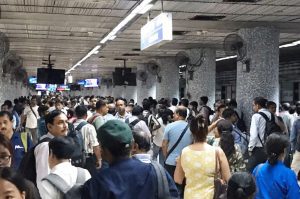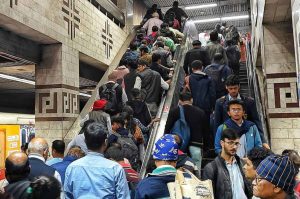Kolkata Metro Breaks Record: Kolkata Metro, the country’s first and one of its busiest urban rail networks, achieved a historic milestone recently by carrying over 8 lakh passengers in a single day. The surge in ridership also translated into ₹1.6 crore in fare revenue, marking the highest single-day ticket collection in the system’s four-decade journey.
Officials highlighted that the feat was made possible due to the simultaneous operation of all five corridors—Blue Line, Green Line, Yellow Line, Orange Line, and Purple Line—following the addition of new stretches and interconnections.

This achievement not only demonstrates the Metro’s growing popularity but also reflects changing urban mobility patterns in Kolkata, where citizens are increasingly prioritizing fast, reliable, and eco-friendly transit options over private vehicles and congested buses.
The Backbone: Blue Line’s Contribution
The North–South corridor (Blue Line), which remains Kolkata Metro’s backbone since its launch in 1984, accounted for 5.8 lakh passengers on that day alone. The line’s revenue contribution stood at over ₹1 crore, reaffirming its role as the lifeline of the network.
Stations like Dum Dum, Esplanade, Kalighat, Gariahat, and Tollygunge continue to handle the bulk of daily footfall, as they connect residential belts with central business districts.
The Rising Star: Green Line (East–West Corridor)
The East–West corridor (Green Line) saw record-breaking ridership of 2 lakh passengers, collecting nearly ₹38 lakh in revenue. This surge followed the inauguration of the Howrah Maidan to Esplanade stretch, which includes the iconic tunnel under the Hooghly River—India’s first underwater metro link.


The new connectivity drastically reduced travel time between Howrah and Sealdah, Kolkata’s busiest railway hubs, to under 15 minutes, transforming the daily commute for thousands of office-goers.
Smaller Lines, Steady Growth
While the Blue and Green lines dominate the numbers, the newer corridors are steadily growing in patronage:
- Yellow Line (Noapara–Airport): ~₹2 lakh revenue
- Orange Line (New Garia–Ruby stretch): ~₹76,000 revenue
- Purple Line (Joka–Taratala): ~₹1 lakh revenue
These lines, though smaller in ridership, are seen as crucial future investments that will decongest traditional routes and ensure seamless connectivity across suburban belts once fully operational.
Peak Footfall at Major Stations
- Dum Dum: ~66,000 passengers
- Esplanade: ~57,000 passengers
- Sealdah: ~49,000 passengers
- Howrah: ~48,000 passengers
These figures reflect how interchange hubs have become pressure points, where suburban rail passengers merge with metro commuters.
Digital Transformation of Ticketing
The Metro Railway has reported that 40% of transactions are now digital, thanks to QR-code-based tickets and smart cards. The adoption of digital payment systems not only reduces queues at ticket counters but also aligns with Kolkata’s move towards smart urban mobility solutions.
Apps like “Aamar Kolkata Metro” are also driving convenience, enabling passengers to book tickets on the go.
Expansion and Economic Impact
The Metro expansion is reshaping the city’s economy:
- Property values near metro stations, particularly along the Green Line, have surged as connectivity improves.
- Businesses along key corridors are witnessing higher footfall, from eateries to shopping centers.
- Metro-linked neighborhoods like Salt Lake, Rajarhat, Behala, and New Garia are becoming more attractive to both residents and investors.
According to reports, the Metro carried 1.9 crore passengers in August 2025, collecting nearly ₹30 crore in revenue, an unprecedented leap. With upcoming festival seasons, ridership is expected to soar even higher.
Historical Context: From 1984 to 2025
Kolkata Metro began operations in 1984, making it India’s first underground rapid transit system. From a single North–South stretch, the network has now grown into a multi-corridor system spanning over 73 km, with ambitious plans to cross 100 km by 2030.
The Metro remains not just a transport system but a symbol of Kolkata’s modernization—one that blends its colonial-era streets with futuristic infrastructure.
Environmental Significance
Experts point out that Kolkata Metro is making a significant dent in reducing vehicular emissions. By carrying 8 lakh passengers in a day, the metro helped eliminate the need for nearly 5 lakh private vehicles on the road, thereby reducing traffic jams, noise pollution, and carbon footprint.
Challenges Ahead
Despite this success, challenges remain:
- Overcrowding at major stations during peak hours
- Last-mile connectivity gaps in suburban areas
- Need for more modern rolling stock to match growing demand
- Delays in project completion for certain extensions
Addressing these issues will be vital to sustaining ridership growth and ensuring commuter satisfaction.
Kolkata Metro Breaks Record: Looking Ahead
Urban planners believe that Kolkata Metro is at the threshold of a transformational decade. With new links like the airport connection on the Yellow Line and the Taratala–Esplanade extension on the Purple Line, the system is poised to rival Delhi Metro in scale and efficiency.
For citizens, the metro is not just about travel—it’s about time saved, opportunities unlocked, and a cleaner, greener Kolkata.
Related External References
Also read: Home | Channel 6 Network – Latest News, Breaking Updates: Politics, Business, Tech & More

